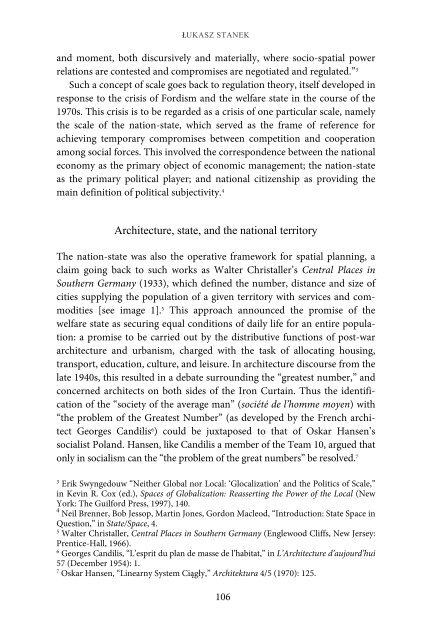Foucault, Biopolitics, and Governmentality
Foucault, Biopolitics, and Governmentality
Foucault, Biopolitics, and Governmentality
Create successful ePaper yourself
Turn your PDF publications into a flip-book with our unique Google optimized e-Paper software.
ŁUKASZ STANEK<br />
<strong>and</strong> moment, both discursively <strong>and</strong> materially, where socio-spatial power<br />
relations are contested <strong>and</strong> compromises are negotiated <strong>and</strong> regulated.” 3<br />
Such a concept of scale goes back to regulation theory, itself developed in<br />
response to the crisis of Fordism <strong>and</strong> the welfare state in the course of the<br />
1970s. This crisis is to be regarded as a crisis of one particular scale, namely<br />
the scale of the nation-state, which served as the frame of reference for<br />
achieving temporary compromises between competition <strong>and</strong> cooperation<br />
among social forces. This involved the correspondence between the national<br />
economy as the primary object of economic management; the nation-state<br />
as the primary political player; <strong>and</strong> national citizenship as providing the<br />
main definition of political subjectivity. 4<br />
Architecture, state, <strong>and</strong> the national territory<br />
The nation-state was also the operative framework for spatial planning, a<br />
claim going back to such works as Walter Christaller’s Central Places in<br />
Southern Germany (1933), which defined the number, distance <strong>and</strong> size of<br />
cities supplying the population of a given territory with services <strong>and</strong> commodities<br />
[see image 1]. 5 This approach announced the promise of the<br />
welfare state as securing equal conditions of daily life for an entire population:<br />
a promise to be carried out by the distributive functions of post-war<br />
architecture <strong>and</strong> urbanism, charged with the task of allocating housing,<br />
transport, education, culture, <strong>and</strong> leisure. In architecture discourse from the<br />
late 1940s, this resulted in a debate surrounding the “greatest number,” <strong>and</strong><br />
concerned architects on both sides of the Iron Curtain. Thus the identification<br />
of the “society of the average man” (société de l’homme moyen) with<br />
“the problem of the Greatest Number” (as developed by the French architect<br />
Georges C<strong>and</strong>ilis 6 ) could be juxtaposed to that of Oskar Hansen’s<br />
socialist Pol<strong>and</strong>. Hansen, like C<strong>and</strong>ilis a member of the Team 10, argued that<br />
only in socialism can the “the problem of the great numbers” be resolved. 7<br />
3 Erik Swyngedouw “Neither Global nor Local: ‘Glocalization’ <strong>and</strong> the Politics of Scale,”<br />
in Kevin R. Cox (ed.), Spaces of Globalization: Reasserting the Power of the Local (New<br />
York: The Guilford Press, 1997), 140.<br />
4<br />
Neil Brenner, Bob Jessop, Martin Jones, Gordon Macleod, “Introduction: State Space in<br />
Question,” in State/Space, 4.<br />
5 Walter Christaller, Central Places in Southern Germany (Englewood Cliffs, New Jersey:<br />
Prentice-Hall, 1966).<br />
6 Georges C<strong>and</strong>ilis, “L’esprit du plan de masse de l’habitat,” in L’Architecture d’aujourd’hui<br />
57 (December 1954): 1.<br />
7 Oskar Hansen, “Linearny System Ciągły,” Architektura 4/5 (1970): 125.<br />
106


